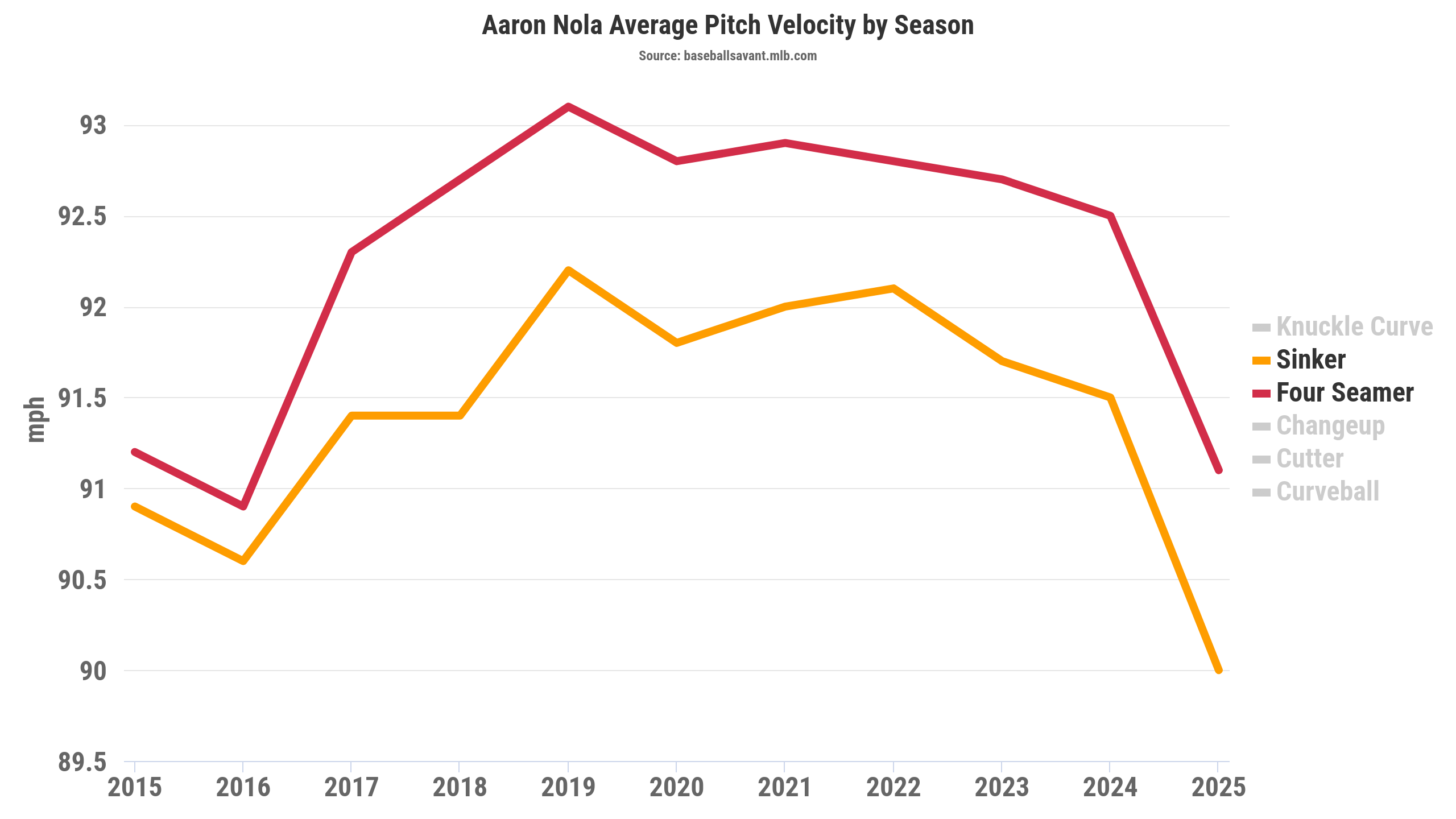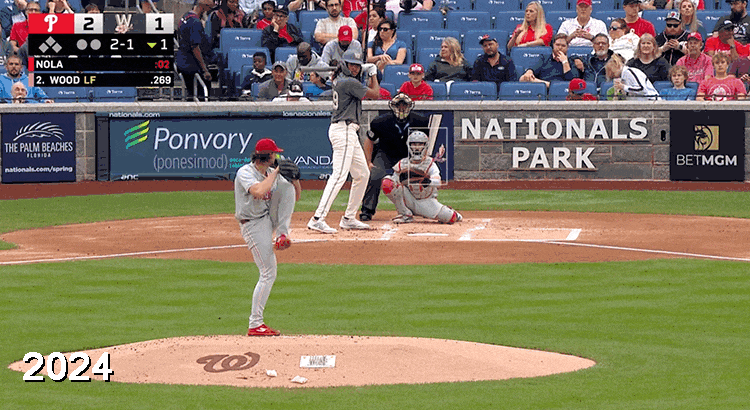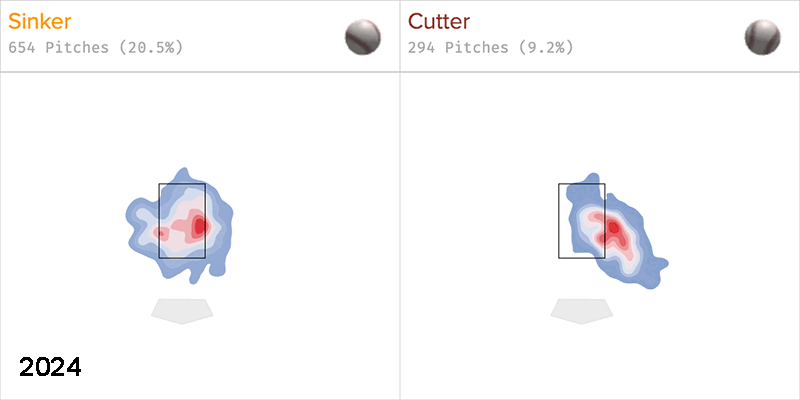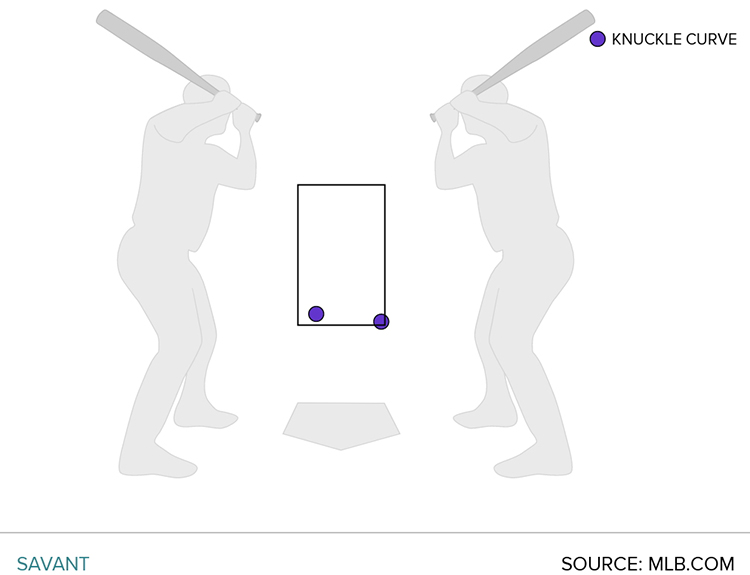Trying To Make Sense of Aaron Nola’s Slow Start

Over his first five starts, Aaron Nola is 0-5 with a 6.43 ERA. On Monday night against the Mets, Nola nearly put up his best performance of the season, allowing two earned runs over six innings before things went off the rails. In the seventh inning, the two runners that he bequeathed to the bullpen scored, leaving him with a final line of 6 1/3 innings and four earned runs. Still, it was an improvement.
No one has more losses or fewer wins than Nola this season. Only three qualified pitchers have a higher ERA. How much should we be panicking right now? I will tell you up front that I don’t know the answer. There’s plenty going on, and I don’t know how to make all the pieces fit neatly, so I’m just going to lay out what I’ve learned. Let’s start with a whole bunch of advanced ERA estimators.
| ERA | FIP | xERA | DRA | SIERA | xFIP | PLA | botERA |
|---|---|---|---|---|---|---|---|
| 6.43 | 4.90 | 4.69 | 3.97 | 3.59 | 3.40 | 3.37 | 3.17 |
At the very least, we can say that Nola doesn’t deserve a 6.43 ERA. Even FIP and xERA, which like him the least, are the only estimators above 4.00. A 3.97 DRA is nothing to write home about, but Nola’s xFIP, PLA, and SIERA are all better this season than last, and PitchingBot thinks he deserves a 3.17 ERA, putting him in the top quartile among qualified starters. Nola’s running a career-high .364 BABIP and one of the lowest strand rates of his career. An absurd 24% of his fly balls have gone for home runs. Clearly, luck and sequencing are playing a factor here. So why are all the Phillies fans you know digging through their sewing kits in case they need to seam-ripper his name off the back of their jerseys?
We have to start with the contract. Nola is in the second season of a seven-year, $172 million deal. He’ll be pitching in Philadelphia into the next decade (and when he’s not pitching in Philadelphia, his contract dictates that he gets a hotel suite on road trips; you’d better believe that I will one day run the numbers on whether players with this particular perk in their contracts actually perform better on the road). Knowing that Nola has five more years left on his deal takes any concern you might have about his performance and multiplies it by a factor of about a thousand. Even if you’re just 1% concerned that Nola might be washed, the idea of him staying washed and clogging up the rotation for the next five seasons – essentially making him Philadelphia’s very own Patrick Corbin – is enough to keep you up at night. That’s just the backdrop. Let’s get into some specific concerns.
The loudest alarm bells are coming from the radar gun. Nola has never had a blazing fastball, but things are looking dangerously lethargic so far this season. His sinker is averaging 90 mph and his four-seamer is averaging 91.1. In 2024, those numbers were 91.5 and 92.5. He’s lost a tick and a half, falling from the 20th percentile in fastball velocity to the seventh. That’s not great. This graph is pretty scary (unless you choose to look at it as Nola’s four-seamer spooning his sinker, in which case it’s absolutely adorable).

While Nola is concerned about the velocity dip, he’s also expecting it to rebound soon. “I think it’s probably an early-season thing,” he told reporters on Monday. “Feel like I do start out with lower velocity when it’s cold and then it starts to tick up when it gets a little bit hotter.” Manager Rob Thomson expressed the same optimism when he met with reporters before Tuesday’s game. As Ethan Witte noted at the Good Phight, the two definitely have a point. Year after year, Nola’s velocity really does tend to start out slow and then increase throughout the first half of the season.

Although the sinker is slower, this year his four-seamer is starting out exactly as fast as it did in 2024. Moreover, for his career in March and April, Nola has a 3.82 FIP and a 3.66 xFIP. Both numbers are his worst of any month. In other words, both literally and figuratively, Nola is always a slow starter. It might be too early to panic about this particular concern, but I don’t think we can just chalk up Nola’s slow start to the lack of velocity and call it a day. Things are about to get more complicated.
Nola is running higher chase, whiff, and strikeout rates than he did in 2024. However, his walk rate is up, and I think something small might be disguising what’s going on. Nola has a 51% edge rate, the highest of all qualified pitchers. That’s great, but that stat has a lot of randomness baked in because hitting the very edges of the strike zone is a hard trick to repeat. Nola has never finished as high as 47%, and no qualified pitcher has ever reached 50% in the pitch tracking era. We should expect that number to regress to the mean, and when it does, all things being equal, we should expect Nola’s chase and contact rates to worsen. Then again, Michael Rosen, our resident pitching expert, told me that when he watched Nola on Monday, he came away with the impression that he was aiming for fine targets intentionally in order to cover for the lack of velocity. Maybe the edge rate isn’t masking Nola’s shortcomings, but rather it’s a response to them. Maybe once Nola feels like he has his best stuff, he’ll go back to attacking hitters.
Here’s another contradiction I can’t really explain. Nola’s whiff rate on pitches over the heart of the plate has nearly doubled, from 10.9% last year to 20% this year. When he hits the strike zone, he’s missing more bats. However, Nola’s exit velocity is 89.8 mph and his hard-hit rate is 41%. Those would be the worst full-season marks of his career, and they aren’t much better when compared to every individual month of his career; that’s the seventh-highest monthly exit velo of his career, and the eighth-highest monthly hard-hit rate. He may always start the season slowly, but only once before has he been hit this hard in the first month of the season, and that was in 2019 — six seasons ago. Why are batters making less contact but mashing the ball when they do connect? I really don’t have a great answer for you.
It’s also important to note that Nola isn’t struggling against everybody. He has shifted four inches closer to the third base side of the rubber this season; he’s still pitching from the first base side, but now the angle is slightly less extreme. It’s subtle, but you can see the difference.

In theory, that should make him a bit tougher on right-handed hitters, as the ball is now coming from farther behind them, and easier on left-handed hitters, as the ball is now coming from farther in front of them. However, we’re talking about a minuscule expected difference over a very small sample size. What’s actually going on is very extreme.
| Season | LHB | RHB |
|---|---|---|
| 2021 | .287 | .306 |
| 2022 | .246 | .281 |
| 2023 | .314 | .294 |
| 2024 | .311 | .309 |
| 2025 | .428 | .328 |
Across his career, Nola has been pretty balanced, allowing a wOBA of .297 to lefties and .287 to righties. This year, lefties are lighting him up. I won’t make you look at another table, but the xwOBA numbers are pretty similar. Lefties are at .409 and righties are at .279. To be clear, I definitely do not think we can pin this on Nola’s mound positioning, but I do think it’s interesting. I wonder if the positioning adjustment is intentional, or whether he just started feeling a bit more comfortable a few inches to the right. Either way, something is going on against lefties.
All of Nola’s pitches have added a small bit of horizontal break, but that’s easily explained. They’re coming in slower, so they have slightly more time to break. Really, his pitches look almost exactly the same; they’re just slower and coming from about four inches closer to the third base side. Most of the locations look the same too, but Nola has been leaving both his sinker and his cutter up in the zone more often than he did last season.

Still, he doesn’t throw the cutter too much, and he throws the sinker far more often to righties than he does to lefties. The sinker is actually performing slightly better this year. In other words, neither of these pitches explains why Nola is struggling so much against lefties.
Nola leads with his curveball against lefties, throwing it nearly a third of the time. For years, the pitch has been his super power, but that’s not so this season. For the first time ever, Statcast lists it with a negative run value. The pitch’s only real change is its drop in velocity, and for what it’s worth, Stuff+ and PitchingBot are both down on the pitch in a big way, but StuffPro likes it nearly as much as it did last season. The pitch is failing Nola for the first time, but its whiff rate is 39.7%, the highest it’s been in years. This early in the season, the sample is small enough that the two home runs Nola has allowed on the curve are skewing the stats fairly heavily. They weren’t exactly meatballs, either. Take a look at the locations.

Maybe Nola would have preferred to bury those pitches below the zone, but it’s not like they caught a ton of plate. The problem was that they were thrown to the wrong corner. Both ended up down and in when they were intended to be down and away, and both got lifted to the pull side, a common trend this season.
Nola has been among the worst culprits this season when it comes to allowing batters to pull the ball in the air. Just under 23% of the batted balls he has allowed this season were line drives or fly balls to the pull side. Among pitchers with at least 50 balls in play, that puts him in just the 13th percentile. But the issue is almost entirely due to Nola’s struggles against lefties. Against righties, Nola is allowing the lowest barrel rate of his career. He’s yet to allow a barrel on a sinker, the pitch he throws the most against righties. Against lefties, his 16.3% barrel rate is nearly double his previous career high. The four-seamer and curveball are running particularly terrifying barrel rates. Nola came into this season with career marks of 5.6% for the curveball and 9.4% for the four-seamer. Right now, those numbers are 13.6% for the curve and 22.2% for the four-seamer.
As I said at the beginning, I don’t necessarily know how to square all of this. A huge proportion of Nola’s fly balls are going for home runs, and that’s usually an indicator of bad luck. However, we probably shouldn’t expect that percentage to drop too much if his barrel and pulled fly ball rates continue to be among the highest in the league. Lefties are reaching down and golfing his curveball like never before, and it’s hard to attribute too much of that to luck. Moreover, all the loud contact is coming at a time when Nola’s whiff rates have climbed. Could it be that batters are seeing Nola’s softer repertoire and swinging out of their shoes, resulting in more big hits and more big whiffs? Baseball Savant’s bat tracking data is also a little complicated.
![]()
So far this season, the average bat speed against Nola is up, but the fast swing rate (the percentage of swings above 75 mph) is down. And when players are making hard contact against him, their average bat speed is slower than it was last season.
I’m sorry to leave you with so much unresolved, so let’s at least recap what we know. Nola has had some bad luck in terms of BABIP and sequencing. His fastball velocity is down, but for now at least, we should probably expect it to bounce back. He’s struggling against lefties, and that’s both new and worrisome. He’s hitting the edges of the zone at an unsustainable rate. He’s racking up plenty of chases and whiffs, but he’s also allowing lots of hard contact. When batters lift the ball, they’re lifting it to the pull side. I’m not sure there’s any way to know just yet which of these variables is going to give. Maybe Nola’s velocity will pick up, at which point batters will stop swinging out of their shoes or find it more difficult to pull the ball in the air. Maybe his edge rate will fall and some of those chase whiffs will disappear. Maybe he just needs to scooch back over four inches to his left. Maybe things will just even out over time. Nola has always tended to alternate between brilliant seasons and ugly seasons. Maybe we’re just due for the latter.
Davy Andrews is a Brooklyn-based musician and a writer at FanGraphs. He can be found on Bluesky @davyandrewsdavy.bsky.social.
Water is dry. Ice is hot. The Marlins have a payroll above the tax line. That’s my takeaway from this.